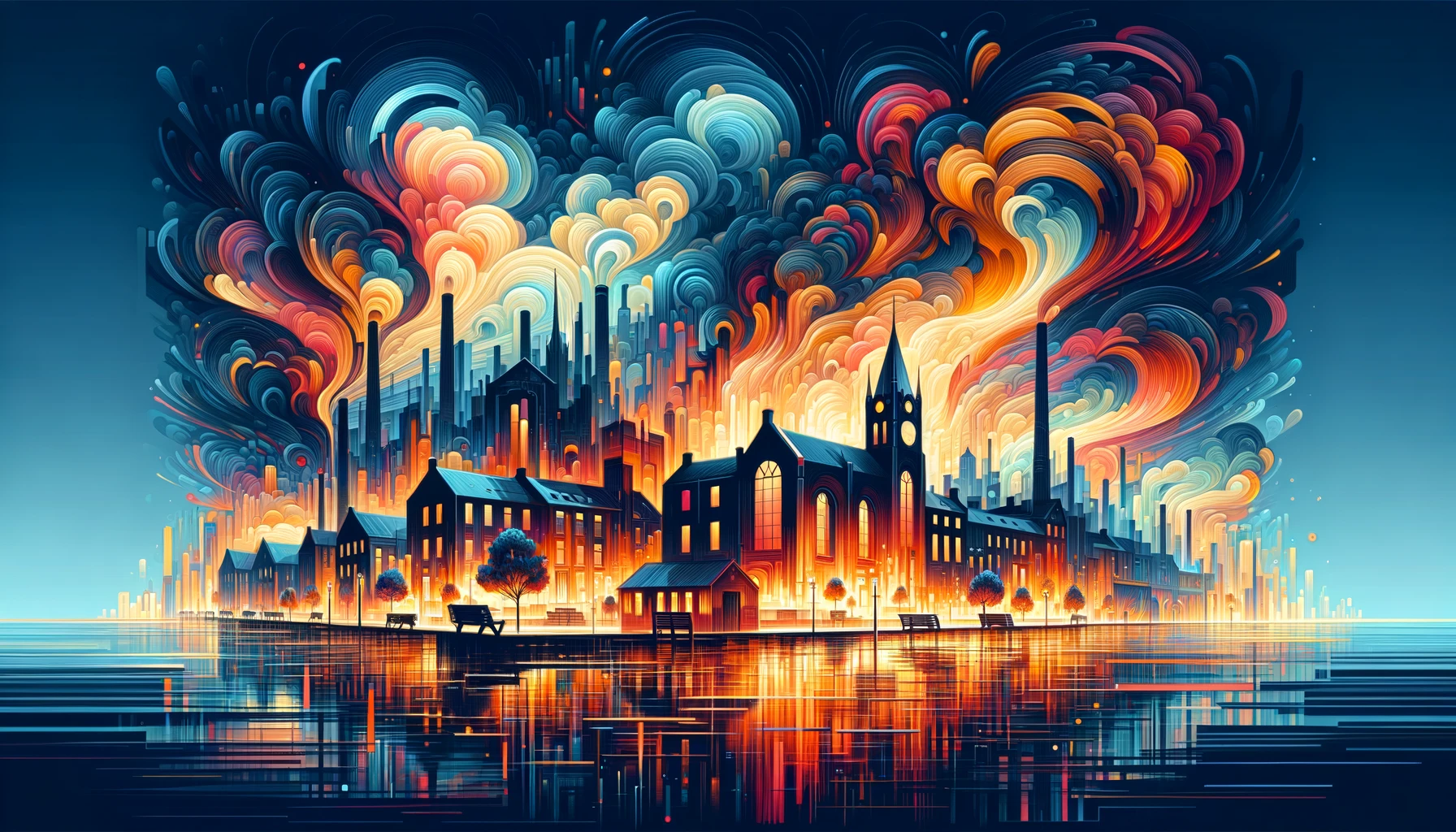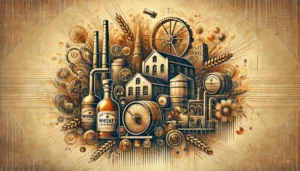Introduction to the Dublin Whiskey Fire
In the annals of history, fires have often reshaped cities and communities, leaving behind tales of destruction and rebirth. Among such tales, the Dublin Whiskey Fire of 1875 holds a unique place, not just for the magnitude of the blaze but for its peculiar cause and the unusual challenges it presented to those attempting to quell it. This event is not merely a historical footnote; it offers a fascinating glimpse into Dublin’s past, its industry, and the resilience of its people.
The fire broke out on the 18th of June, 1875, in the Liberties area of Dublin, a bustling district known for its whiskey distilleries, dense housing, and vibrant street life. What set this fire apart was not the destruction of buildings or the loss of goods, but the river of burning whiskey that flowed through the streets, igniting everything in its path. This bizarre and fiery spectacle attracted onlookers and posed a unique challenge to firefighters and residents alike.
The Dublin Whiskey Fire was more than an urban disaster; it was a reflection of the city’s industrial landscape, characterized by the large-scale storage of flammable materials in urban centers. This event prompts us to explore not only the specific circumstances of the fire but also the broader implications for fire safety, urban planning, and the regulation of industrial activities within city limits.
As we delve into the story of the Dublin Whiskey Fire of 1875, we will uncover the origins of the blaze, trace its devastating path through the Liberties, and examine the aftermath and the lessons learned. This article aims not only to recount the events of that day but also to illuminate the impact of the fire on Dublin’s development and the legacy it left behind.
The Origin of the Fire
The Dublin Whiskey Fire of 1875 ignited under circumstances that were as unique as they were tragic. The event began on a seemingly ordinary Saturday in the Liberties area, a district teeming with industrial activity and home to some of Dublin’s most renowned whiskey distilleries. The precise start of the fire was at the Malone’s Malt House on Chamber Street, a location integral to the whiskey production process.

On that fateful day, an accidental spark, the exact source of which remains a matter of historical speculation, found its way to one of the storage areas where whiskey was kept in large quantities. The storage conditions of the time, which often involved wooden casks and less-than-ideal safety measures, contributed to the rapid spread of the fire. Once ignited, the alcohol fueled a blaze unlike any the city had witnessed before.
As the flames engulfed the malt house, they ruptured additional casks, releasing more whiskey and intensifying the fire. The whiskey, now alight, began to flow out of the premises, turning the streets into rivers of fire. This unusual and dangerous situation posed a significant challenge to the firefighters and the local population. The conventional methods of firefighting, which relied heavily on water, were not only ineffective but also risked exacerbating the situation by spreading the flaming whiskey further.
The response to the fire required innovation and bravery. Residents and firefighters alike had to adapt quickly, using sand, gravel, and manure to contain and eventually extinguish the rivers of fire. The community’s efforts to combat the blaze were hampered by the lack of preparedness for such an unconventional disaster, highlighting the need for improved safety standards and emergency response strategies.
This tragic event marked a turning point in the management of industrial risks within urban areas. It underscored the dangers posed by the storage of large quantities of flammable substances in densely populated districts and led to a reevaluation of safety practices and regulations within the whiskey industry and beyond.
The origins of the Dublin Whiskey Fire serve as a cautionary tale about the potential hazards of industrial activities and the importance of safety measures in preventing similar disasters. As we reflect on the events of that day, we are reminded of the resilience of the Dublin community and the lessons learned in the face of adversity.
Impact and Spread of the Fire
The Dublin Whiskey Fire of 1875 quickly transformed from a local incident to a citywide catastrophe, affecting vast swaths of the Liberties area and beyond. The fire’s impact was not just physical; it left a lasting mark on the city’s social and economic fabric.

Path of Destruction
The inferno’s path was dictated by the flowing whiskey, which turned streets into conduits for the fire. Starting from Malone’s Malt House on Chamber Street, the blaze spread through Cork Street, one of the main thoroughfares in the Liberties, igniting homes, businesses, and warehouses in its wake. The fire’s spread was unprecedented, fueled by the alcohol and exacerbated by the densely packed wooden buildings characteristic of 19th-century Dublin.
Affected Areas
Entire blocks were engulfed, with the flames claiming not only the premises of whiskey producers but also the livelihoods of many small tradesmen and residents. The area’s tightly knit community faced displacement, with countless families losing their homes and possessions. Notably, despite the widespread destruction of property, the casualty rate was remarkably low, a testament to the swift evacuation efforts and the fortunate absence of explosions typically associated with fires of this nature.
Economic and Social Impact
The economic repercussions were felt immediately, with the whiskey industry suffering significant losses. Small businesses and artisans, already grappling with the challenges of urban life in the 19th century, found themselves at a crossroads, their futures uncertain. The fire highlighted the precarious balance between industrial progress and public safety, prompting a reevaluation of urban planning and industrial storage practices.
In the aftermath, the community’s resilience shone through. The rebuilding efforts showcased a determination to recover and rebuild, often with improved fire safety measures in place. However, the memory of the fire lingered, serving as a cautionary tale of the risks inherent in urban industrialization.
Legacy of the Fire
The Dublin Whiskey Fire of 1875 is remembered not only for the immediate devastation it caused but also for the lessons it imparted. It prompted changes in fire safety regulations, particularly concerning the storage of flammable materials, and influenced urban planning decisions to prevent similar disasters. The fire remains a poignant reminder of the need for vigilance and preparedness in the face of unforeseen dangers.
Response and Recovery
As the Dublin Whiskey Fire of 1875 blazed through the Liberties, a coordinated response effort was launched to combat the unprecedented challenge. The fire demanded not only immediate action to save lives and property but also a thoughtful approach to recovery and rebuilding in its aftermath.

Firefighting Efforts
The typical response to a fire of this magnitude would involve vast quantities of water. However, the unique nature of this disaster, with whiskey fueling the flames, required innovative solutions. Firefighters and volunteers resorted to using sand, gravel, and even blankets to smother the flames, a strategy that proved effective but labor-intensive. Local distilleries and breweries contributed their horse-drawn drays to transport these materials to the front lines of the fire.
The community played a crucial role, with citizens forming human chains to pass buckets of sand and water to those battling the blaze. This collective effort highlighted the resilience and solidarity of Dublin’s residents, who came together in the face of adversity.
Aftermath and Recovery
Once the flames were extinguished, the city faced the daunting task of recovery. The immediate focus was on providing shelter and aid to those displaced by the fire. Charitable organizations, churches, and the city council mobilized to support the affected families, offering food, clothing, and temporary housing.
The reconstruction of the Liberties area prompted a reflection on urban planning and fire safety. The disaster served as a catalyst for change, leading to the implementation of stricter regulations on the storage of flammable materials and the construction of buildings. Efforts were made to rebuild the affected areas with improved safety measures, including wider streets to act as firebreaks and the use of less flammable building materials.
Reflection and Change
The Dublin Whiskey Fire of 1875 left an indelible mark on the city’s history, serving as a reminder of the risks associated with industrial progress. The response and recovery efforts demonstrated the community’s capacity to overcome adversity and rebuild stronger than before. This event also spurred changes in fire safety and urban planning, contributing to the development of modern Dublin.
As the city moved forward, the legacy of the fire continued to influence public policy and community initiatives, ensuring that the lessons learned were not forgotten. The spirit of resilience and cooperation displayed during the response and recovery phases remains a testament to Dublin’s strength in the face of disaster.
Legacy of the Fire
The Dublin Whiskey Fire of 1875, though a tragic event, left behind a legacy that has shaped the city of Dublin and its approach to industrial safety and urban planning. The fire’s aftermath forced city officials, businesses, and citizens to reconsider the balance between industrial development and public safety, leading to significant changes that have had a lasting impact.

Regulatory Changes and Safety Measures
In the wake of the fire, there was a concerted effort to improve fire safety regulations, particularly concerning the storage of flammable materials like whiskey. Stricter building codes were implemented, focusing on fireproof materials and the inclusion of firebreaks in urban designs. These measures were designed to prevent the spread of fires and ensure that disasters of a similar nature could be contained more effectively.
Additionally, the disaster prompted the whiskey industry to adopt safer storage practices, including the use of fire-resistant materials for casks and the establishment of storage facilities away from densely populated areas. These changes not only safeguarded the city from future fires but also protected the industry’s valuable stocks from potential loss.
Impact on Urban Development
The Liberties area, heavily affected by the fire, saw significant redevelopment in its aftermath. The rebuilding efforts were characterized by a focus on safer, more spacious urban layouts that could better accommodate emergency responses. This incident underscored the need for careful urban planning that considers the risks associated with industrial activities within city limits.
Cultural and Historical Significance
The Dublin Whiskey Fire has entered the annals of Dublin’s history not just as a cautionary tale but also as a testament to the city’s resilience and community spirit. Museums and historical societies have preserved the memory of the fire, ensuring that future generations understand its significance. It serves as a reminder of the importance of community solidarity and the need for ongoing vigilance in fire safety and urban planning.
A Continuing Legacy
Today, the legacy of the Dublin Whiskey Fire of 1875 lives on, influencing not only the physical landscape of Dublin but also the policies and practices that protect its inhabitants. The event is a poignant reminder of the challenges posed by urban industrialization and the importance of preparedness and adaptability in the face of disaster. As Dublin continues to grow and evolve, the lessons learned from the whiskey fire remain relevant, guiding the city towards a safer and more resilient future.








Be First to Comment